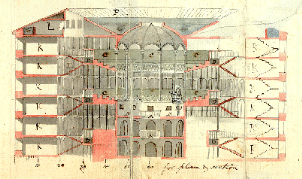
Image: courtesy University College London Library
Go to Jeremy Bentham's Panopticon Letters (1787) and detailed architectural specifications for his surveillance machine.
16 June 2001
Transcription and HTML by Cartome
| |
Go to Jeremy Bentham's Panopticon Letters (1787) and detailed architectural specifications for his surveillance machine. |
Theory of Surveillance: The PANOPTICON
The PANOPTICON was proposed as a model prison by Jeremy Bentham (1748-1832), a Utilitarian philosopher and theorist of British legal reform.
The Panopticon ("all-seeing") functioned as a round-the-clock surveillance machine. Its design ensured that no prisoner could ever see the 'inspector' who conducted surveillance from the privileged central location within the radial configuration. The prisoner could never know when he was being surveilled -- mental uncertainty that in itself would prove to be a crucial instrument of discipline.
French philosopher Michel Foucault described the implications of 'Panopticism' in his 1975 work Discipline & Punish: The Birth of the Prison --
"Hence
the major effect of the Panopticon: to induce in the inmate a state of conscious
and permanent visibility that assures the automatic functioning of power. So
to arrange things that the surveillance is permanent in its effects, even if
it is discontinuous in its action; that the perfection of power should tend
to render its actual exercise unnecessary; that this architectural apparatus
should be a machine for creating and sustaining a power relation independent
of the person who exercises it; in short, that the inmates should be caught
up in a power situation of which they are themselves the bearers. To achieve
this, it is at once too much and too little that the prisoner should be constantly
observed by an inspector: too little, for what matters is that he knows himself
to be observed; too much, because he has no need in fact of being so. In view
of this, Bentham laid down the principle that power should be visible and unverifiable.
Visible: the inmate will constantly have before his eyes the tall outline of
the central tower from which he is spied upon. Unverifiable: the inmate must
never know whether he is being looked at at any one moment; but he must be sure
that he may always be so. In order to make the presence or absence of the inspector
unverifiable, so that the prisoners, in their cells, cannot even see a shadow,
Bentham envisaged not only venetian blinds on the windows of the central observation
hall, but, on the inside, partitions that intersected the hall at right angles
and, in order to pass from one quarter to the other, not doors but zig-zag openings;
for the slightest noise, a gleam of light, a brightness in a half-opened door
would betray the presence of the guardian. The Panopticon is a machine for dissociating
the see/being seen dyad: in the peripheric ring, one is totally seen, without
ever seeing; in the central tower, one sees everything without ever being seen."
excerpt from 'Panopticism'
in Foucault, Michel
Discipline & Punish: The Birth of the Prison
(NY: Vintage Books 1995) pp. 195-228
translated from the French by Alan Sheridan (translation � 1977)
go to Jeremy Bentham's Panopticon Letters